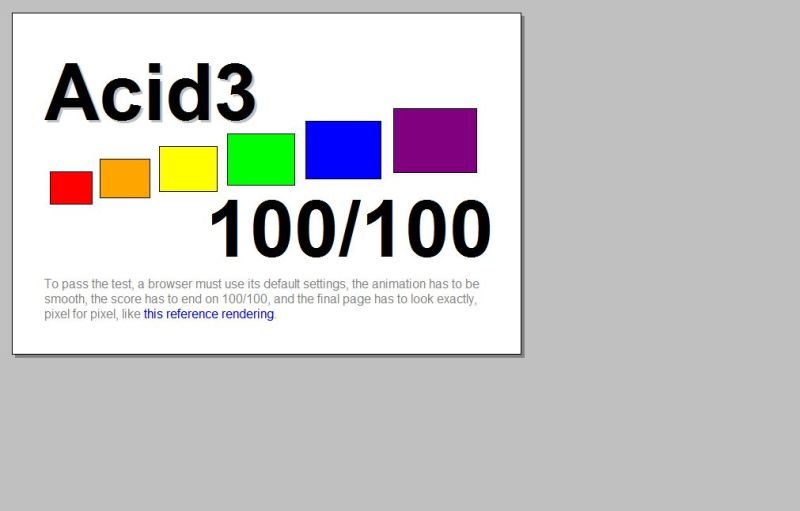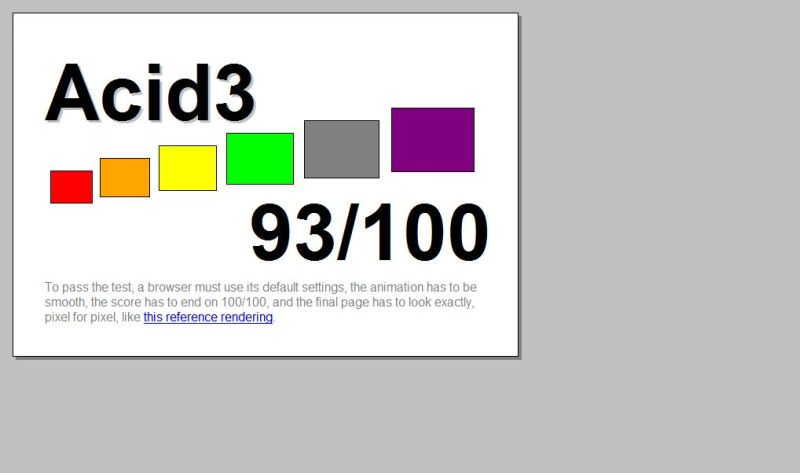acid-3 tests on several browsers
The Problem…
It’s a no-brainer: the web browser your XP computer came with is garbage, and every web professional knows it. It renders web pages inaccurately, it doesn’t follow web standards, it’s buggy, it’s slow, and it’s not very secure. Web developers are forced to waste billions of dollars per year coding and testing work-arounds for IE.
IE 6 is terrible, 7 is a tiny bit better (fixes some things, breaks others), and 8 is just 7 with a few new features and a slightly different subset of problems. So, why do “they” continue to produce buggy, nonstandard browsers? I suspect it’s because they know that web developers will code for their many problems, and thus make all the real browsers break! As always, they attempt to maintain control of their market-share by doing everything in their own secret proprietary way. But it doesn’t work: web pros go to great lengths to make pages render properly (more or less) in both standards-compliant browsers and garbage browsers. They have to.
Why People Don’t Change Browsers
It’s so easy to download and install a new browser! Opera, FireFox, and Chrome all have a one-button install on their web sites. They will all import your IE bookmarks and settings and start working right away. It takes just a few minutes to start using a real browser. So why don’t people just do it? Well, apparently most people know nothing at all about IE’s many problems, and many people have never installed or upgraded anything since they bought their computer. They think that it’s an unknown and scary operation and so they don’t have the time or desire to mess with it. Baloney!
What Problems?
The web, and web standards, are evolving. Many new features are available to web developers that add functionality and improve the appearance of properly coded web pages. But to use these new features, end-users need a real browser—and aside from all that, IE doesn’t even render much of regular web page code properly. There are hundreds of issues that have been around for years; things like IE broken box model, broken floats, broken overflows, margin, border, and padding bugs; and many more. There are many good web sites devoted to these infernal issues.
One such site, by web standards guru Ian Hickson, is acidtests.org. The Acid 3 test feeds your browser about 100 tests designed to determine standards compatibility. I recently installed 4 versions of IE, along with Opera, FireFox, and Chrome. Then I ran each one on the Acid 3 test, and captured the screens for your enjoyment (your results may vary):
IE 5.5

IE 6

IE 7

IE 8

Opera 10

Chromium 6

FireFox 3.5.9

Reference: This is what they all should look like:

Note that the acid 3 page isn’t just making some text and graphics. It’s doing a bunch of standards-compatibility tests and generating the screen therefrom; if any part of the generated page does not look exactly like the reference, then one or more tests have failed and the browser is buggy. As you can see, Opera and Chrome generated perfect scores, while 4 versions of IE failed miserably. You would see these browser bugs in all the web sites you visit if they were coded to standards, without IE bug workarounds!
Not shown in my screen-caps above are the several long pauses and “error” boxes that manifest when running the tests on IE browsers. The good browsers zip through these tests, nice and smoothly, in about 4 seconds.
Ok, So What Else?
In addition to better rendering of web pages, real browsers are
- free and open-source,
- highly configurable to your style,
- highly extensible with plug-ins,
- much faster, particularly on Javascript;
- much more secure,
- easy to install and uninstall,
- easy to upgrade,
- portable versions are available (run on your USB stick), and
- just better in every way.
So just go ahead. Get a real browser.
You’ll be glad you did.
—kv5r (June 2010)



